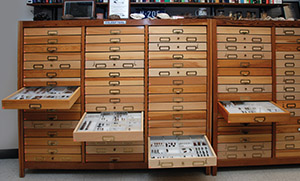The Purdue Entomological Research Collection (PERC) traces its origins to 14 cases of insect specimens held by Purdue’s Zoological Museum in 1879. Though nothing remains of those early collections, likely used for teaching, the present collection has grown to include nearly 2 million specimens, representing more than 140,000 species.
“Without question, the PERC is one of Purdue’s most valuable natural history resources,” says Gino Nearns, collections manager. “The specimens and associated data function as a reference library for students, scientists, and researchers from around the world.”
Housed in the basement of Smith Hall since 1988, the PERC is moderately sized for a university-held collection. However, it is distinguished by having several collections of historical significance, including what is widely regarded as the largest and most comprehensive collection of mayflies in the world.
Though particularly strong in its aquatic insect holdings, the collection also contains other important insects such as beetles, flies, moths, and butterflies. Nearns and PERC Director Jennifer Zaspel, assistant professor of entomology, work with a team of researchers to acquire thousands of new specimens each year in countries such as Australia, Bolivia, and Costa Rica. Additionally, the collection serves as a repository for specimens obtained through student and faculty research.

“We are also fortunate to have collaborators and friends of the collection who make generous donations of curated and identified specimens,” says Zaspel. In July, the PERC received 1,200 beautifully curated insects from entomology alumnus James Wappes (A’68).
To accommodate the growing collection, a grant proposal was submitted to the National Science Foundation to upgrade equipment and make the data associated with the specimens available online.
“We will continue to expand this tremendous resource,” says Zaspel, “Eventually we want to develop an on-campus venue for public education, outreach, and natural history collections.”
What are your favorite hidden gems on campus? Let us know in the comments below.

